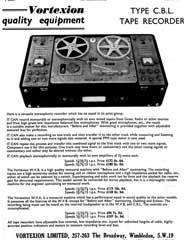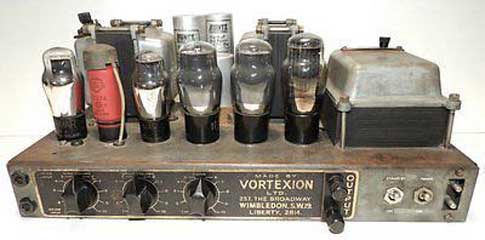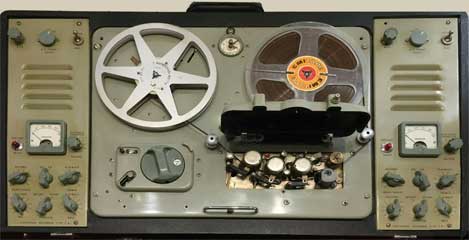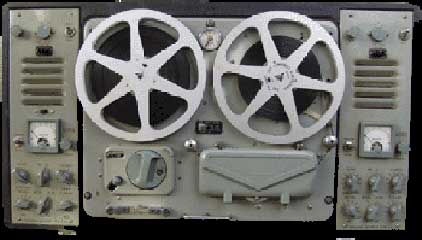British Vortexion Ltd
Vortexion Ltd of Wimbledon was a notable British manufacturer of high quality public address amplifiers, mixers and much later, tape recorders. Having been formed in October 1936 by two brothers, Sidney and Edward Brown. Vortexion was born out of a small shop trading under the name of Brown and Salter, who had been a supplier of components, later specialising in transformers. Nothing further is known about Salter who does not appear to have featured in the later history of the firm or in the formation of Vortexion Ltd.
The firm originally traded from 182 The Broadway, Wimbledon and expanded a little further along the road into premises at  257-263 The Broadway. With the unexpected death of Edward Brown in the February of 1942, Sidney’s wife, Dorothy assumed the position of a director. Although never a large concern, at their peak in the 1950s, Vortexion products sold in relatively large numbers as evidenced by the survival rate of some of this equipment today.
257-263 The Broadway. With the unexpected death of Edward Brown in the February of 1942, Sidney’s wife, Dorothy assumed the position of a director. Although never a large concern, at their peak in the 1950s, Vortexion products sold in relatively large numbers as evidenced by the survival rate of some of this equipment today.
By 1937 their first portable amplifier was introduced under the Vortexion brand name, capable of operating from the mains, or off a 12V battery, drawing some 6 amps. The CP20 could deliver a 15W output.
With the outbreak of war, the firm found themselves under the direction of the UK Government for war work, and during this time the CP20 had been joined by an amplifier chassis featuring a pair of 6L6s in the output stage. Vortexion claimed that many hundreds of these were in use by the ARP and government. The claimed output from this amplifier was 50W.
Post war they produced a recording amplifier type AD47 for disc recording purposes and a Magnetophon recording and  replay amplifier in the summer of 1947 specifically to drive the German originated magnetic tape recorder deck of the same name. This development makes them an early, if not indirect entrant into the tape recording field as the UK did not see magnetic recording commercially introduced until a little later with the professional EMI BTR1. The domestic markets would have to wait until 1948/9 before the emergence of a complete home tape recorder such as those produced by Ferrograph and the Thermionic Products “Soundmirror”. Vortexion did not produce their own self contained recorder for these markets until early 1953 a subject which will be returned to shortly.
replay amplifier in the summer of 1947 specifically to drive the German originated magnetic tape recorder deck of the same name. This development makes them an early, if not indirect entrant into the tape recording field as the UK did not see magnetic recording commercially introduced until a little later with the professional EMI BTR1. The domestic markets would have to wait until 1948/9 before the emergence of a complete home tape recorder such as those produced by Ferrograph and the Thermionic Products “Soundmirror”. Vortexion did not produce their own self contained recorder for these markets until early 1953 a subject which will be returned to shortly.
In early 1949, the firm announced a stereophonic amplifier using as the output valve in each channel, a single PX4. Unfortunately, nothing further is known about this development although the equipment continued to be advertised in one form or another throughout the early 1950s.
 Vortexion eventually entered the tape recorder market in 1953 with their first “A” model, followed by the WVA and WVB series. The design changed very little until the final model, the stereo CBL6 of 1967 which was considered by some to be the finest stereo reel to reel tape recorder ever produced in the UK. All of the machines used the Ferrograph Wearite tape transport making Vortexion one of the largest users of the deck with Clarke and Smith a very close second. With the demise of the Wearite deck in early 1968, Vortexion briefly marketed the CBL7/ T this was designed around the ill fated Ferrograph Series 7 deck launched later that year. The new range was abruptly withdrawn after a considerable investment in the development of the new recorder, with the subsequent marketing yielding few sales. The late 1960s also saw Vortexion make the move into transistors and one of the first of the designs to appear was the CP50, a 50watt amplifier. This was still being advertised under the CSI banner as late as 1979. Vortexion do not appear to have attempted to produce any Hi-Fi amplifiers choosing it would seem, to remain in the more specialised markets of sound reinforcement.
Vortexion eventually entered the tape recorder market in 1953 with their first “A” model, followed by the WVA and WVB series. The design changed very little until the final model, the stereo CBL6 of 1967 which was considered by some to be the finest stereo reel to reel tape recorder ever produced in the UK. All of the machines used the Ferrograph Wearite tape transport making Vortexion one of the largest users of the deck with Clarke and Smith a very close second. With the demise of the Wearite deck in early 1968, Vortexion briefly marketed the CBL7/ T this was designed around the ill fated Ferrograph Series 7 deck launched later that year. The new range was abruptly withdrawn after a considerable investment in the development of the new recorder, with the subsequent marketing yielding few sales. The late 1960s also saw Vortexion make the move into transistors and one of the first of the designs to appear was the CP50, a 50watt amplifier. This was still being advertised under the CSI banner as late as 1979. Vortexion do not appear to have attempted to produce any Hi-Fi amplifiers choosing it would seem, to remain in the more specialised markets of sound reinforcement.
Vortexion eventually entered the tape recorder market in 1953 with their first “A” model, followed by the WVA and WVB series. The design changed very little until the final model, the stereo CBL6 of 1967 which was considered by s ome to be the finest stereo reel to reel tape recorder ever produced in the UK. All of the machines used the Ferrograph Wearite tape transport making Vortexion one of the largest users of the deck with Clarke and Smith a very close second. With the demise of the Wearite deck in early 1968, Vortexion briefly marketed the CBL7/ T this was designed around the ill fated Ferrograph Series 7 deck launched later that year. The new range was abruptly withdrawn after a considerable investment in the development of the new recorder, with the subsequent marketing yielding few sales. The late 1960s alsosaw Vortexion make the move into transistors and one of the first of the designs to appear was the CP50, a 50watt amplifier. This was still being advertised under the CSI banner as late as 1979. Vortexion do not appear to have attempted to pr
ome to be the finest stereo reel to reel tape recorder ever produced in the UK. All of the machines used the Ferrograph Wearite tape transport making Vortexion one of the largest users of the deck with Clarke and Smith a very close second. With the demise of the Wearite deck in early 1968, Vortexion briefly marketed the CBL7/ T this was designed around the ill fated Ferrograph Series 7 deck launched later that year. The new range was abruptly withdrawn after a considerable investment in the development of the new recorder, with the subsequent marketing yielding few sales. The late 1960s alsosaw Vortexion make the move into transistors and one of the first of the designs to appear was the CP50, a 50watt amplifier. This was still being advertised under the CSI banner as late as 1979. Vortexion do not appear to have attempted to pr
The amplifier range continued to be made alongside the Clarke and Smith schools equipment, with development work and production already in progress on the CSI Vortexion System 2000 and an early announcement in the Wireless World of July 1975 proclaimed that the new amplifier “combined the aesthetics of design in the domestic field with the near flexibility of a modular system”.
This range was joined in the summer of 1979 by the VTN30 a 3 channel 30w amplifier, and later the VTN5a, an early induction loop amplifier. The final designs introduced were the Series 3000 during the 1980s with the final development appearing as the Series 4000, these were to include induction loop amplifiers such as the model 469, and a return to the battery powered amplifier in the 455 50 watt mixer amplifier that harked back to the CP50. With the demise of Clarke and Smith the brand name was sold off to Hagger Electronics of Letchworth, Hertfordshire who discontinued all but the induction loop amplifier range. This legendary brand name still survives today (just) in this specialised market.
Ferrographworld



